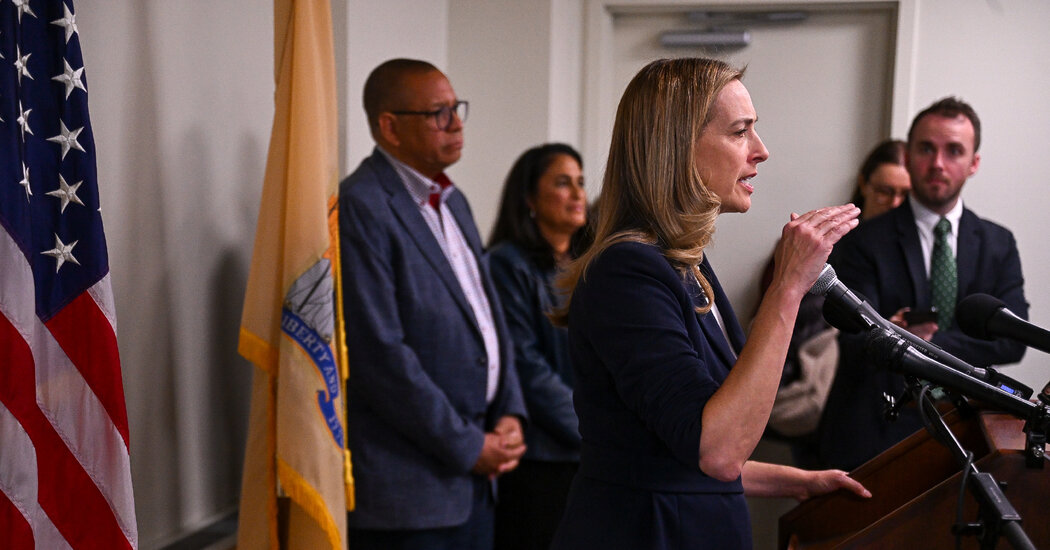Less than 24 hours after she was elected governor of New Jersey by a resounding margin, Representative Mikie Sherrill headed to Trenton on Wednesday to outline her plan to capitalize on what she called a “seismic” win in parts of the state, and a clear mandate to lead.
“What I saw was that our message was resonating,” Ms. Sherrill said as she stood with her transition team leaders, Dale Caldwell, her lieutenant governor, and Kellie Doucette, one of her former legislative directors in Congress.
Ms. Sherrill, a Democrat, said residents of what she called “working-class communities” share many of the same priorities: better schools, good job opportunities and cheaper prescription drugs.
“They want to be able to afford a home, to start to build generational wealth,” Ms. Sherrill said.
Ms. Sherrill won election by a 13-point margin as voter turnout surged, fueled at least in part by anger over the tumultuous first months of President Trump’s second term, which she had made a focal point of her campaign. More than 3.2 million New Jersey residents cast ballots, up nearly 600,000 from the governor’s race four years ago.
Ms. Sherrill noted that she won the majority of votes in far-flung and disparate parts of the state, including Gloucester County, a rural community in South Jersey; Morris County, a suburban region in the northern part of the state; and Newark, the state’s largest city.
Ms. Sherrill, 53, also met Wednesday with the outgoing governor, Philip D. Murphy, a two-term Democrat, who she said had offered guidance on how to best use the 77 days before she is sworn in as New Jersey’s 57th governor.
Asked whether she thought she now had a mandate in New Jersey, she said, “Yes.”
“A very good one.”
Ms. Sherrill inherits a raft of urgent challenges, including anticipated reductions in federal Medicaid funding, a structural deficit in the state budget and gaps left by the Trump administration’s decision to freeze funding for food stamps during the government shutdown.
Governor Murphy has fast-tracked the distribution of $42 million in state funds already planned for organizations that address food insecurity. He also directed the New Jersey Army National Guard to pitch in at food banks and pantries. But he said there are limits to what the state can do, without federal funding.
“They’re sitting on about $6 billion, and they’re choosing to allow people to go hungry,” Mr. Murphy said in the State House after his meeting with Ms. Sherrill. “That’s a choice that they’ve made, which I think is so cruel and so not who we are as a country.”
A White House official said on Tuesday that the federal government would make partial payments for food stamps for November to comply with a court order.
A four-term House member from New Jersey’s 11th Congressional District, Ms. Sherrill defeated Jack Ciattarelli, a Republican who had been endorsed by Mr. Trump, after a race defined largely by national issues and the president’s divisive policies.
Most polls had shown Ms. Sherrill with at least a modest lead. But on Wednesday, in a virtual news conference, Democratic Party leaders said that her margin of victory, and similarly strong showings by Democrats in other key races, were indicators that the party was headed in the right direction.
In Virginia, Abigail Spanberger, a former Democratic House member, was elected governor by a 15-point margin.
Only New Jersey and Virginia hold races for governor the year after a presidential election, and the results are often considered early referendums on voter attitudes toward the president.
The Democrats’ success in both states suggests strong momentum heading into the 2026 midterm races that will determine party control of Congress, Ken Martin, chairman of the Democratic National Committee, said on Wednesday in a virtual news conference.
“These were not just wins for us,” said Meghan Meehan-Draper, executive director of the Democratic Governors Association. “These were landslides.”
Tracey Tully is a reporter for The Times who covers New Jersey, where she has lived for more than 20 years.
The post After ‘Seismic’ Win, New Jersey’s Next Governor Says She Has a Mandate appeared first on New York Times.




